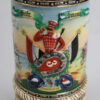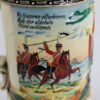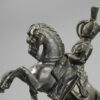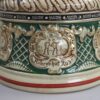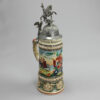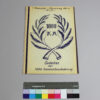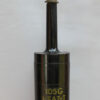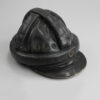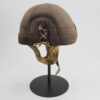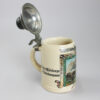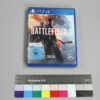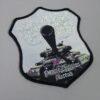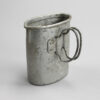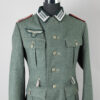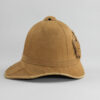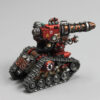Reservist mug of a Zieten-Husaren
Inventory number: DPM 7.116
This richly decorated reservist mug belonged to Private Siebmann, who had it made as a souvenir after his three years of military service from 1905-1908 with the 5th squadron of the Hussar Regiment von Zieten (Brandenburg) No. 3 in Rathenow. Cavalrymen served one year longer than other conscripts, as training with the riding horse took more time.
This ceramic jug holds one liter, but was not used for drinking beer. Back then, a jug like this could cost more than a soldier’s monthly salary. Reservistika were also a sign of a person’s pride in having served in the army. The popularity of souvenirs can also be linked to the reputation the army enjoyed at the time. Reservistika in all forms appeared from 1870 onwards, with crockery, shot glasses, pipes and commemorative pictures. From 1900 onwards, ever larger and more elaborate mugs were designed and soon mass-produced due to the high demand. Representatives with catalogs and sample models travelled to the garrisons and offered to customize the tankards. The mugs always featured the soldier’s name, unit, place of service and period of service. The painting of the background could also be chosen. Hardly any mugs were made during the First World War and, as a professional army, the Reichswehr had no conscripts or reservists.
The center of this equestrian stein is adorned with a soldier wearing the characteristic hussar jacket decorated with trimmings, which was called Attila. He is surrounded by the flags of Brandenburg and the German Empire, which on the one hand emphasizes the Prussian-Brandenburg roots of the regiment in the 18th century and on the other hand the regiment’s membership in the imperial-national contingent army at the time the stein was made. The number 3 in the horseshoe is the regiment’s number. In the background are two equestrian scenes: a farewell to a lover and an attack scene with the slogan “Where hussars attack, the strongest enemy must lose.” The quick stroke and the unclean painting of the jug indicate that it too was already mass-produced.
An interesting detail is hidden on the pewter lid of the jug: the lid figure shows a rider with a rearing horse, which has a glass eye. It is a Stanhope magnifying glass with a photomicrograph glued to the flat end, which can be viewed through the magnifying glass. It shows, for example, a portrait of an emperor or other military scenes. The picture is missing from our jug.
There are mugs for reservists from all branches of the armed forces and regions of the German Empire. It was not only cavalrymen who had mugs made, but also infantrymen, artillerymen, marines, military bakers, railwaymen and butchers. The steins were mainly used in the south, such as in Bavaria, Baden-Württemberg and Hesse, but also in Saxony, Brandenburg and Berlin.
Object of the month
(short) stories from the depot
Unfortunately, many objects cannot currently be shown in the exhibition for conservation reasons. Here you will find unusual objects and exciting stories of special pieces from the depot


